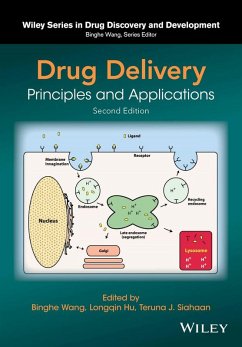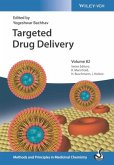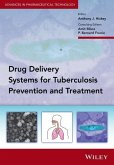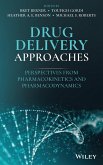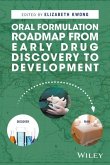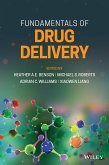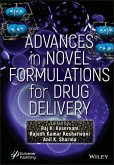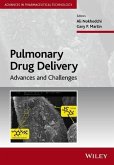Binghe Wang, Longqin Hu, Teruna J. SiahaanPrinciples and Applications
Drug Delivery
Principles and Applications
Herausgeber: Wang, Binghe; Siahaan, Teruna J; Hu, Longqin
Binghe Wang, Longqin Hu, Teruna J. SiahaanPrinciples and Applications
Drug Delivery
Principles and Applications
Herausgeber: Wang, Binghe; Siahaan, Teruna J; Hu, Longqin
- Gebundenes Buch
- Merkliste
- Auf die Merkliste
- Bewerten Bewerten
- Teilen
- Produkt teilen
- Produkterinnerung
- Produkterinnerung
Following its successful predecessor, this book covers the fundamentals, delivery routes and vehicles, and practical applications of drug delivery. In the 2nd edition, almost all chapters from the previous are retained and updated and several new chapters added to make a more complete resource and reference.
_ Helps readers understand progress in drug delivery research and applications _ Updates and expands coverage to reflect advances in materials for delivery vehicles, drug delivery approaches, and therapeutics _ Covers recent developments including transdermal and mucosal delivery,…mehr
Andere Kunden interessierten sich auch für
![Targeted Drug Delivery Targeted Drug Delivery]() Targeted Drug Delivery159,00 €
Targeted Drug Delivery159,00 €![Delivery Systems for Tuberculosis Prevention and Treatment Delivery Systems for Tuberculosis Prevention and Treatment]() Delivery Systems for Tuberculosis Prevention and Treatment183,99 €
Delivery Systems for Tuberculosis Prevention and Treatment183,99 €![Drug Delivery Approaches Drug Delivery Approaches]() Drug Delivery Approaches233,99 €
Drug Delivery Approaches233,99 €![Oral Formulation Roadmap from Early Drug Discovery to Development Oral Formulation Roadmap from Early Drug Discovery to Development]() Oral Formulation Roadmap from Early Drug Discovery to Development158,99 €
Oral Formulation Roadmap from Early Drug Discovery to Development158,99 €![Fundamentals of Drug Delivery Fundamentals of Drug Delivery]() Fundamentals of Drug Delivery232,99 €
Fundamentals of Drug Delivery232,99 €![Advances in Novel Formulations for Drug Delivery Advances in Novel Formulations for Drug Delivery]() Advances in Novel Formulations for Drug Delivery247,99 €
Advances in Novel Formulations for Drug Delivery247,99 €![Pulmonary Drug Delivery Pulmonary Drug Delivery]() Pulmonary Drug Delivery192,99 €
Pulmonary Drug Delivery192,99 €-
-
-
Following its successful predecessor, this book covers the fundamentals, delivery routes and vehicles, and practical applications of drug delivery. In the 2nd edition, almost all chapters from the previous are retained and updated and several new chapters added to make a more complete resource and reference.
_ Helps readers understand progress in drug delivery research and applications
_ Updates and expands coverage to reflect advances in materials for delivery vehicles, drug delivery approaches, and therapeutics
_ Covers recent developments including transdermal and mucosal delivery, lymphatic system delivery, theranostics
_ Adds new chapters on nanoparticles, controlled drug release systems, theranostics, protein and peptide drugs, and biologics delivery
Hinweis: Dieser Artikel kann nur an eine deutsche Lieferadresse ausgeliefert werden.
_ Helps readers understand progress in drug delivery research and applications
_ Updates and expands coverage to reflect advances in materials for delivery vehicles, drug delivery approaches, and therapeutics
_ Covers recent developments including transdermal and mucosal delivery, lymphatic system delivery, theranostics
_ Adds new chapters on nanoparticles, controlled drug release systems, theranostics, protein and peptide drugs, and biologics delivery
Hinweis: Dieser Artikel kann nur an eine deutsche Lieferadresse ausgeliefert werden.
Produktdetails
- Produktdetails
- Wiley series in drug discovery and development
- Verlag: Wiley / Wiley & Sons
- Artikelnr. des Verlages: 1W118833360
- 2. Aufl.
- Seitenzahl: 720
- Erscheinungstermin: 18. April 2016
- Englisch
- Abmessung: 236mm x 160mm x 41mm
- Gewicht: 1157g
- ISBN-13: 9781118833360
- ISBN-10: 1118833368
- Artikelnr.: 42057027
- Herstellerkennzeichnung
- Libri GmbH
- Europaallee 1
- 36244 Bad Hersfeld
- gpsr@libri.de
- Wiley series in drug discovery and development
- Verlag: Wiley / Wiley & Sons
- Artikelnr. des Verlages: 1W118833360
- 2. Aufl.
- Seitenzahl: 720
- Erscheinungstermin: 18. April 2016
- Englisch
- Abmessung: 236mm x 160mm x 41mm
- Gewicht: 1157g
- ISBN-13: 9781118833360
- ISBN-10: 1118833368
- Artikelnr.: 42057027
- Herstellerkennzeichnung
- Libri GmbH
- Europaallee 1
- 36244 Bad Hersfeld
- gpsr@libri.de
Binghe Wang, PhD, is Regents' Professor of Chemistry and Associate Dean for Natural and Computational Sciences at Georgia State University as well as Georgia Research Alliance Eminent Scholar in Drug Discovery. He is Editor-in-Chief of the journal Medicinal Research Review and founding series editor of the Wiley Series in Drug Discovery and Development. He has published over 230 papers in medicinal chemistry, pharmaceutical chemistry, new diagnostics, and chemosensing. Longqin Hu, PhD, is Professor of Medicinal Chemistry and Director of the Graduate Program in Medicinal Chemistry at Rutgers University. Among his major research interests are the synthesis and evaluation of anticancer prodrugs for the targeted activation in tumor tissues and the discovery of novel small molecule inhibitors of protein-protein interactions. He has published over 80 papers and 8 patents in bioorganic and medicinal chemistry. Teruna Siahaan, PhD, is a Professor and Associate Chair of the Department of Pharmaceutical Chemistry and serves as the Director of the NIH Biotechnology Training Program at the University of Kansas. In addition to co-editing the first edition of Drug Delivery, he has written almost 195 journal papers and book chapters and received the 2014 PhRMA Foundation Award in Excellence in Pharmaceutics.
List of Contributors xvii
Preface xxi
1 Factors that Impact the Developability of Drug Candidates 1
Chao Han and Binghe Wang
1.1 Challenges Facing the Pharmaceutical Industry 1
1.2 Factors that Impact Developability 5
1.3 Remarks on Developability 12
1.4 Drug Delivery Factors that Impact Developability 13
References 15
2 Physiological, Biochemical, and Chemical Barriers to Oral Drug Delivery 19
Paul Kiptoo, Anna M. Calcagno, and Teruna J. Siahaan
2.1 Introduction 19
2.2 Physiological Barriers to Drug Delivery 20
2.3 Biochemical Barriers to Drug Delivery 25
2.4 Chemical Barriers to Drug Delivery 28
2.5 Drug Modifications to Enhance Transport Across Biological Barriers 29
2.6 Conclusions 31
Acknowledgment 31
References 31
3 Physicochemical Properties, Formulation, and Drug Delivery 35
Dewey H. Barich, Mark T. Zell, and Eric J. Munson
3.1 Introduction 35
3.2 Physicochemical Properties 36
3.3 Formulations 42
3.4 Drug Delivery 43
3.5 Conclusion 47
References 47
4 Targeted Bioavailability: A Fresh Look at Pharmacokinetic and Pharmacodynamic Issues in Drug Discovery and Development 49
Christine Xu
4.1 Introduction 49
4.2 Target Bioavailability 50
4.3 Drug Delivery Trends and Targets Related to PK and PD 51
4.4 PK-PD in Drug Discovery and Development 51
4.5 Source of Variability of Drug Response 55
4.6 Recent Development and Issues of Bio?]Analytical Methodology 57
4.7 Mechanistic PK-PD Models 58
4.8 Summary 60
References 60
5 The Role of Transporters in Drug Delivery and Excretion 62
Marilyn E. Morris and Xiaowen Guan
5.1 Introduction 62
5.2 Drug Transport in Absorption and Excretion 63
5.3 ABC (ATP?]Binding Cassette) Transporter Family 67
5.4 SlC (Solute Carrier) Transporter Family 76
5.5 Conclusions 88
Acknowledgment 88
References 89
6 Intracellular Delivery and Disposition of Small?]Molecular?]Weight Drugs 103
Jeffrey P. Krise
6.1 Introduction 103
6.2 The Relationship between the Intracellular Distribution of a Drug and its Activity 104
6.3 The Relationship between the Intracellular Distribution of a Drug and its Pharmacokinetic Properties 104
6.4 Overview of Approaches to Study Intracellular Drug Disposition 105
6.5 The Accumulation of Drugs in Mitochondria, Lysosomes, and Nuclei 108
6.6 Summary and Future Directions 123
References 124
7 Cell Culture Models for Drug Transport Studies 131
Irina Kalashnikova, Norah Albekairi, Shariq Ali, Sanaalarab Al Enazy, and Erik Rytting
7.1 Introduction 131
7.2 General Considerations 132
7.3 Intestinal Epithelium 133
7.4 The Blood-Brain Barrier 135
7.5 Nasal and Pulmonary Epithelium 137
7.6 The Ocular Epithelial and Endothelial Barriers 141
7.7 The Placental Barrier 142
7.8 The Renal Epithelium 143
7.9 3D In Vitro Models 145
7.10 Conclusions 146
References 146
8 Intellectual Property and Regulatory Issues in Drug Delivery Research 152
Shahnam Sharareh and Wansheng Jerry Liu
8.1 Introduction 152
8.2 Pharmaceutical Patents 153
8.3 Statutory Requirements for Obtaining a Patent 154
8.4 Patent Procurement Strategies 157
8.5 Regulatory Regime 158
8.6 FDA Market Exclusivities 160
8.7 Regulatory an
Preface xxi
1 Factors that Impact the Developability of Drug Candidates 1
Chao Han and Binghe Wang
1.1 Challenges Facing the Pharmaceutical Industry 1
1.2 Factors that Impact Developability 5
1.3 Remarks on Developability 12
1.4 Drug Delivery Factors that Impact Developability 13
References 15
2 Physiological, Biochemical, and Chemical Barriers to Oral Drug Delivery 19
Paul Kiptoo, Anna M. Calcagno, and Teruna J. Siahaan
2.1 Introduction 19
2.2 Physiological Barriers to Drug Delivery 20
2.3 Biochemical Barriers to Drug Delivery 25
2.4 Chemical Barriers to Drug Delivery 28
2.5 Drug Modifications to Enhance Transport Across Biological Barriers 29
2.6 Conclusions 31
Acknowledgment 31
References 31
3 Physicochemical Properties, Formulation, and Drug Delivery 35
Dewey H. Barich, Mark T. Zell, and Eric J. Munson
3.1 Introduction 35
3.2 Physicochemical Properties 36
3.3 Formulations 42
3.4 Drug Delivery 43
3.5 Conclusion 47
References 47
4 Targeted Bioavailability: A Fresh Look at Pharmacokinetic and Pharmacodynamic Issues in Drug Discovery and Development 49
Christine Xu
4.1 Introduction 49
4.2 Target Bioavailability 50
4.3 Drug Delivery Trends and Targets Related to PK and PD 51
4.4 PK-PD in Drug Discovery and Development 51
4.5 Source of Variability of Drug Response 55
4.6 Recent Development and Issues of Bio?]Analytical Methodology 57
4.7 Mechanistic PK-PD Models 58
4.8 Summary 60
References 60
5 The Role of Transporters in Drug Delivery and Excretion 62
Marilyn E. Morris and Xiaowen Guan
5.1 Introduction 62
5.2 Drug Transport in Absorption and Excretion 63
5.3 ABC (ATP?]Binding Cassette) Transporter Family 67
5.4 SlC (Solute Carrier) Transporter Family 76
5.5 Conclusions 88
Acknowledgment 88
References 89
6 Intracellular Delivery and Disposition of Small?]Molecular?]Weight Drugs 103
Jeffrey P. Krise
6.1 Introduction 103
6.2 The Relationship between the Intracellular Distribution of a Drug and its Activity 104
6.3 The Relationship between the Intracellular Distribution of a Drug and its Pharmacokinetic Properties 104
6.4 Overview of Approaches to Study Intracellular Drug Disposition 105
6.5 The Accumulation of Drugs in Mitochondria, Lysosomes, and Nuclei 108
6.6 Summary and Future Directions 123
References 124
7 Cell Culture Models for Drug Transport Studies 131
Irina Kalashnikova, Norah Albekairi, Shariq Ali, Sanaalarab Al Enazy, and Erik Rytting
7.1 Introduction 131
7.2 General Considerations 132
7.3 Intestinal Epithelium 133
7.4 The Blood-Brain Barrier 135
7.5 Nasal and Pulmonary Epithelium 137
7.6 The Ocular Epithelial and Endothelial Barriers 141
7.7 The Placental Barrier 142
7.8 The Renal Epithelium 143
7.9 3D In Vitro Models 145
7.10 Conclusions 146
References 146
8 Intellectual Property and Regulatory Issues in Drug Delivery Research 152
Shahnam Sharareh and Wansheng Jerry Liu
8.1 Introduction 152
8.2 Pharmaceutical Patents 153
8.3 Statutory Requirements for Obtaining a Patent 154
8.4 Patent Procurement Strategies 157
8.5 Regulatory Regime 158
8.6 FDA Market Exclusivities 160
8.7 Regulatory an
List of Contributors xvii
Preface xxi
1 Factors that Impact the Developability of Drug Candidates 1
Chao Han and Binghe Wang
1.1 Challenges Facing the Pharmaceutical Industry 1
1.2 Factors that Impact Developability 5
1.3 Remarks on Developability 12
1.4 Drug Delivery Factors that Impact Developability 13
References 15
2 Physiological, Biochemical, and Chemical Barriers to Oral Drug Delivery 19
Paul Kiptoo, Anna M. Calcagno, and Teruna J. Siahaan
2.1 Introduction 19
2.2 Physiological Barriers to Drug Delivery 20
2.3 Biochemical Barriers to Drug Delivery 25
2.4 Chemical Barriers to Drug Delivery 28
2.5 Drug Modifications to Enhance Transport Across Biological Barriers 29
2.6 Conclusions 31
Acknowledgment 31
References 31
3 Physicochemical Properties, Formulation, and Drug Delivery 35
Dewey H. Barich, Mark T. Zell, and Eric J. Munson
3.1 Introduction 35
3.2 Physicochemical Properties 36
3.3 Formulations 42
3.4 Drug Delivery 43
3.5 Conclusion 47
References 47
4 Targeted Bioavailability: A Fresh Look at Pharmacokinetic and Pharmacodynamic Issues in Drug Discovery and Development 49
Christine Xu
4.1 Introduction 49
4.2 Target Bioavailability 50
4.3 Drug Delivery Trends and Targets Related to PK and PD 51
4.4 PK-PD in Drug Discovery and Development 51
4.5 Source of Variability of Drug Response 55
4.6 Recent Development and Issues of Bio?]Analytical Methodology 57
4.7 Mechanistic PK-PD Models 58
4.8 Summary 60
References 60
5 The Role of Transporters in Drug Delivery and Excretion 62
Marilyn E. Morris and Xiaowen Guan
5.1 Introduction 62
5.2 Drug Transport in Absorption and Excretion 63
5.3 ABC (ATP?]Binding Cassette) Transporter Family 67
5.4 SlC (Solute Carrier) Transporter Family 76
5.5 Conclusions 88
Acknowledgment 88
References 89
6 Intracellular Delivery and Disposition of Small?]Molecular?]Weight Drugs 103
Jeffrey P. Krise
6.1 Introduction 103
6.2 The Relationship between the Intracellular Distribution of a Drug and its Activity 104
6.3 The Relationship between the Intracellular Distribution of a Drug and its Pharmacokinetic Properties 104
6.4 Overview of Approaches to Study Intracellular Drug Disposition 105
6.5 The Accumulation of Drugs in Mitochondria, Lysosomes, and Nuclei 108
6.6 Summary and Future Directions 123
References 124
7 Cell Culture Models for Drug Transport Studies 131
Irina Kalashnikova, Norah Albekairi, Shariq Ali, Sanaalarab Al Enazy, and Erik Rytting
7.1 Introduction 131
7.2 General Considerations 132
7.3 Intestinal Epithelium 133
7.4 The Blood-Brain Barrier 135
7.5 Nasal and Pulmonary Epithelium 137
7.6 The Ocular Epithelial and Endothelial Barriers 141
7.7 The Placental Barrier 142
7.8 The Renal Epithelium 143
7.9 3D In Vitro Models 145
7.10 Conclusions 146
References 146
8 Intellectual Property and Regulatory Issues in Drug Delivery Research 152
Shahnam Sharareh and Wansheng Jerry Liu
8.1 Introduction 152
8.2 Pharmaceutical Patents 153
8.3 Statutory Requirements for Obtaining a Patent 154
8.4 Patent Procurement Strategies 157
8.5 Regulatory Regime 158
8.6 FDA Market Exclusivities 160
8.7 Regulatory an
Preface xxi
1 Factors that Impact the Developability of Drug Candidates 1
Chao Han and Binghe Wang
1.1 Challenges Facing the Pharmaceutical Industry 1
1.2 Factors that Impact Developability 5
1.3 Remarks on Developability 12
1.4 Drug Delivery Factors that Impact Developability 13
References 15
2 Physiological, Biochemical, and Chemical Barriers to Oral Drug Delivery 19
Paul Kiptoo, Anna M. Calcagno, and Teruna J. Siahaan
2.1 Introduction 19
2.2 Physiological Barriers to Drug Delivery 20
2.3 Biochemical Barriers to Drug Delivery 25
2.4 Chemical Barriers to Drug Delivery 28
2.5 Drug Modifications to Enhance Transport Across Biological Barriers 29
2.6 Conclusions 31
Acknowledgment 31
References 31
3 Physicochemical Properties, Formulation, and Drug Delivery 35
Dewey H. Barich, Mark T. Zell, and Eric J. Munson
3.1 Introduction 35
3.2 Physicochemical Properties 36
3.3 Formulations 42
3.4 Drug Delivery 43
3.5 Conclusion 47
References 47
4 Targeted Bioavailability: A Fresh Look at Pharmacokinetic and Pharmacodynamic Issues in Drug Discovery and Development 49
Christine Xu
4.1 Introduction 49
4.2 Target Bioavailability 50
4.3 Drug Delivery Trends and Targets Related to PK and PD 51
4.4 PK-PD in Drug Discovery and Development 51
4.5 Source of Variability of Drug Response 55
4.6 Recent Development and Issues of Bio?]Analytical Methodology 57
4.7 Mechanistic PK-PD Models 58
4.8 Summary 60
References 60
5 The Role of Transporters in Drug Delivery and Excretion 62
Marilyn E. Morris and Xiaowen Guan
5.1 Introduction 62
5.2 Drug Transport in Absorption and Excretion 63
5.3 ABC (ATP?]Binding Cassette) Transporter Family 67
5.4 SlC (Solute Carrier) Transporter Family 76
5.5 Conclusions 88
Acknowledgment 88
References 89
6 Intracellular Delivery and Disposition of Small?]Molecular?]Weight Drugs 103
Jeffrey P. Krise
6.1 Introduction 103
6.2 The Relationship between the Intracellular Distribution of a Drug and its Activity 104
6.3 The Relationship between the Intracellular Distribution of a Drug and its Pharmacokinetic Properties 104
6.4 Overview of Approaches to Study Intracellular Drug Disposition 105
6.5 The Accumulation of Drugs in Mitochondria, Lysosomes, and Nuclei 108
6.6 Summary and Future Directions 123
References 124
7 Cell Culture Models for Drug Transport Studies 131
Irina Kalashnikova, Norah Albekairi, Shariq Ali, Sanaalarab Al Enazy, and Erik Rytting
7.1 Introduction 131
7.2 General Considerations 132
7.3 Intestinal Epithelium 133
7.4 The Blood-Brain Barrier 135
7.5 Nasal and Pulmonary Epithelium 137
7.6 The Ocular Epithelial and Endothelial Barriers 141
7.7 The Placental Barrier 142
7.8 The Renal Epithelium 143
7.9 3D In Vitro Models 145
7.10 Conclusions 146
References 146
8 Intellectual Property and Regulatory Issues in Drug Delivery Research 152
Shahnam Sharareh and Wansheng Jerry Liu
8.1 Introduction 152
8.2 Pharmaceutical Patents 153
8.3 Statutory Requirements for Obtaining a Patent 154
8.4 Patent Procurement Strategies 157
8.5 Regulatory Regime 158
8.6 FDA Market Exclusivities 160
8.7 Regulatory an

